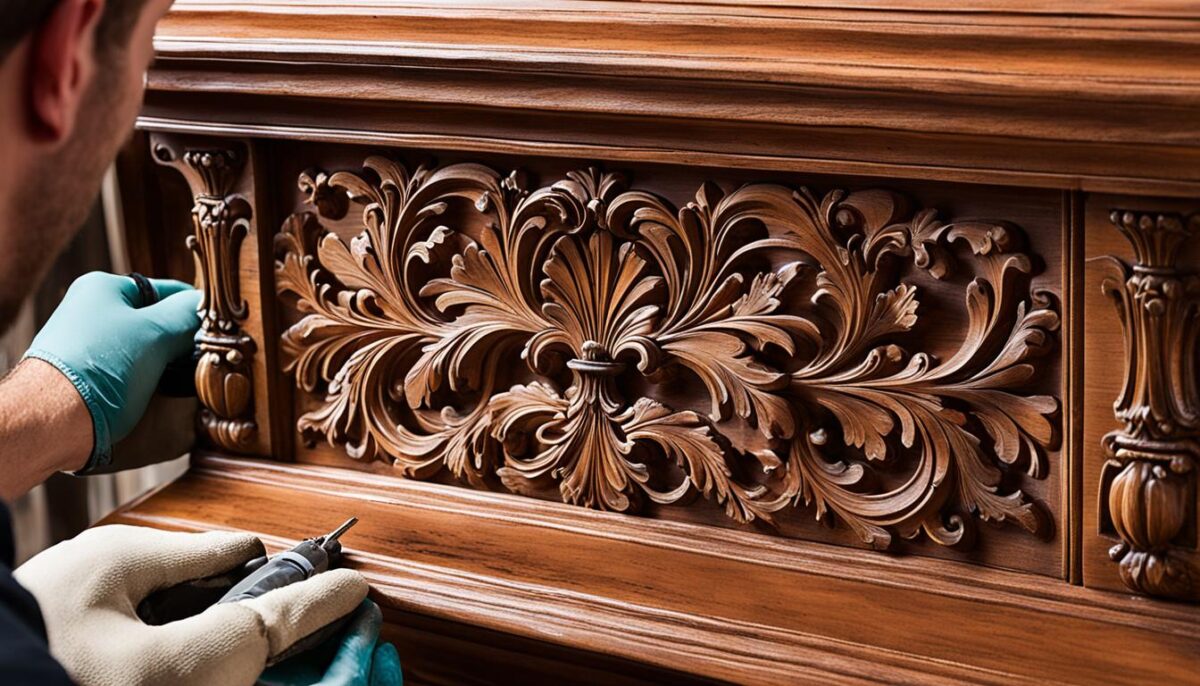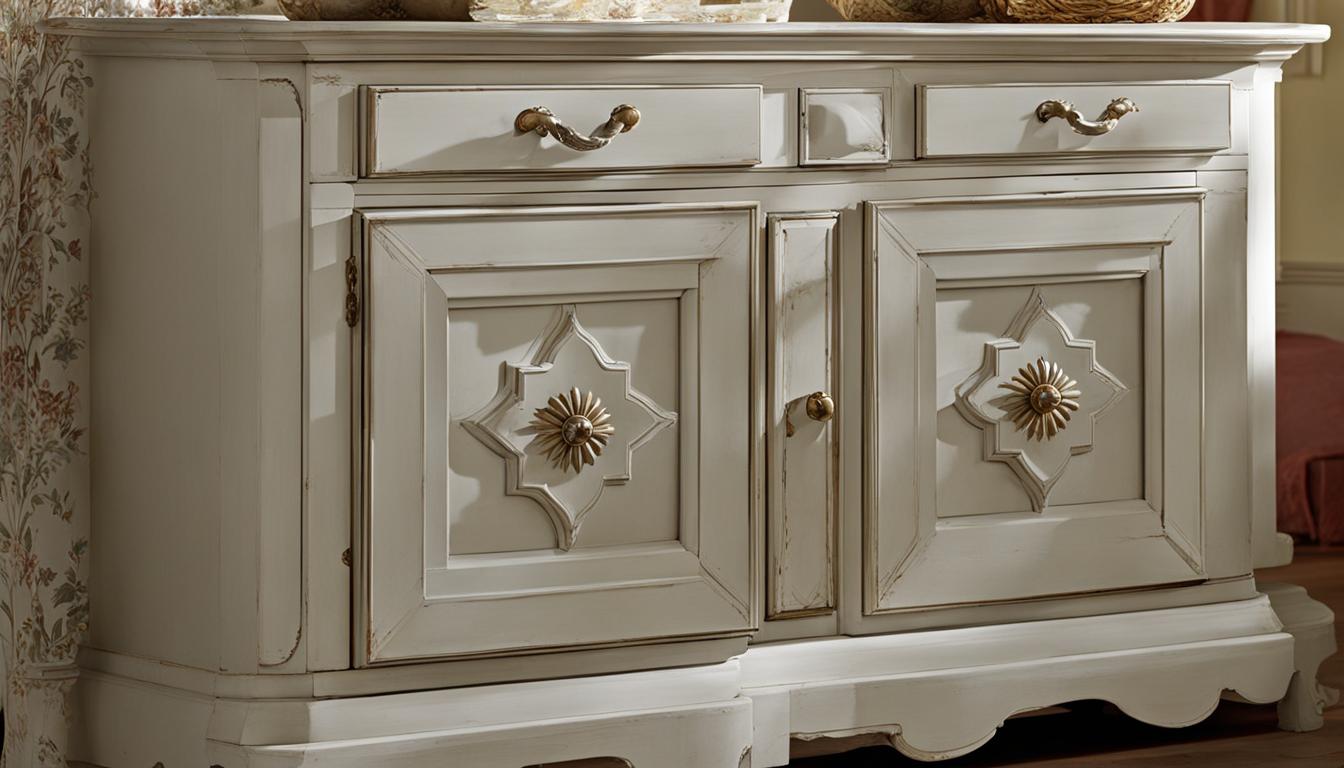Do you have an antique cabinet that’s in need of a fresh new look? Look no further! In this article, we’ll guide you through the process of transforming your beloved antique cabinet and reviving its classic charm.
Whether you’ve inherited a family heirloom or stumbled upon a hidden gem at a flea market, giving your antique cabinet a makeover can breathe new life into its timeless beauty. With the right techniques and a little creativity, you can transform your antique cabinet into a stunning focal point that blends seamlessly with your decor.
From choosing the perfect finish and paint to restoring and repairing any damages, we’ll cover every step of the process. We’ll also discuss how to enhance your antique cabinet with new hardware while maintaining its vintage appeal.
Refinishing an antique cabinet requires some careful techniques, and we’ll provide you with the know-how to achieve professional-looking results. And once your makeover is complete, we’ll share styling and display ideas to showcase your revitalized cabinet in all its glory.
Lastly, we’ll delve into maintenance and care tips to ensure that your antique cabinet continues to shine for years to come. Proper care will preserve its classic charm and protect your investment.
So, let’s dive in and discover how to transform your antique cabinet into a stunning piece that will revive the classic charm of your space.
Choosing the Right Finish and Paint
When it comes to transforming your antique cabinet, the choice of finish and paint plays a crucial role in achieving the desired aesthetic. Whether you want to preserve the timeless elegance or add a modern touch, selecting the perfect finish and paint is essential for a successful antique cabinet makeover.
Let’s explore the different finish options you can consider:
- Varnish: A durable and protective finish that enhances the natural beauty of the wood.
- Wax: Offers a soft and warm finish while providing protection to the wood surface.
Now, let’s guide you through the process of choosing the ideal paint color and type:
- Consider the existing decor: Take into account the colors and style of the room where the antique cabinet will be placed. Opt for a paint color that complements the overall ambiance.
- Classic vs. contemporary: Decide whether you want to maintain the traditional charm of the antique cabinet or bring a modern flair to it. This will help you determine whether to choose muted, earthy tones or bold, vibrant colors.
- Paint type: Consider the type of paint that suits your specific needs. For instance, chalk paint offers a rustic and textured finish, while satin or gloss paint provides a smooth and polished look.
Remember to always prioritize the preservation of the antique cabinet’s original character and consider consulting with experts if you are unsure about the best finish and paint options.
“The right finish and paint can truly transform an antique cabinet, breathing new life into it while staying true to its heritage.” – Expert Antique Restorer
To help you visualize the possibilities, here’s an example of an antique cabinet makeover:
Here is a finished table with details on the “Before” and “After” images for visual comparison:
Restoring and Repairing
Antique cabinets are not only beautiful pieces of furniture but also hold sentimental value. Over time, these treasures may show signs of wear and damage. To bring your antique cabinet back to its former glory, it’s essential to restore and repair it with care.
Assessing the Condition
Before diving into the restoration process, it’s crucial to assess the condition of your antique cabinet. Carefully examine the wood, joints, hardware, and any existing finishes. Look for cracks, chips, loose parts, missing pieces, or signs of pest damage. Taking note of the areas that require attention will help you create a comprehensive restoration plan.
Fixing Damages
Once you’ve identified the areas in need of repair, you can begin fixing the damages. Whether it’s a loose joint, broken piece of wood, or damaged veneer, there are several techniques you can use to restore the structural integrity of your antique cabinet.
“Repairing antique cabinets requires patience and attention to detail. Take your time and proceed cautiously to avoid further damage.”
If you’re dealing with loose joints, applying wood glue and clamping the parts together can help restore stability. For broken or missing pieces, consider sourcing matching wood or contacting a professional woodworker for assistance. Veneer repairs may involve carefully removing damaged sections and replacing them with matching or complementary veneer.
Restoring the Finish
Restoring the original finish of your antique cabinet is an important step in the restoration process. Stripping the current finish using appropriate techniques and products will allow you to reveal the natural beauty of the wood. A gentle sanding can help smooth out any imperfections, followed by the application of a new finish that complements the cabinet’s style.
Remember to choose finishes and products that are compatible with antique furniture to ensure long-lasting results. It’s wise to test any new products or techniques on a small, inconspicuous area of the cabinet before applying them to the entire piece.
With patience, care, and attention to detail, restoring and repairing your antique cabinet can be a rewarding process. By saving these timeless pieces, you not only preserve their historical value but also extend their lifespan, allowing future generations to appreciate their beauty.
Enhancing with New Hardware
Adding new hardware to your antique cabinet is a simple and effective way to update its look and give it a fresh twist. Whether you’re replacing worn-out handles or want to incorporate a new design element, updating the cabinet hardware can instantly transform the overall appearance of your cherished piece. In this section, we’ll explore various options for antique cabinet hardware, discuss the process of replacing cabinet hardware, and provide tips on updating cabinet handles while maintaining the vintage charm of the piece.
When choosing new hardware for your antique cabinet, consider the style and era of the piece. Opt for hardware that complements the overall aesthetic while adding a touch of modernity. Antique brass, bronze, or ceramic knobs and pulls are popular choices that can enhance the character of your cabinet.
Replacing cabinet hardware requires careful attention to detail to ensure a seamless transition. Here’s a step-by-step guide to help you through the process:
- Start by removing the existing hardware using a screwdriver or appropriate tools.
- Measure the hole spacing to determine the size of the new hardware.
- Select the desired cabinet handles or knobs that fit your cabinet’s design and size.
- Align the new hardware with the existing holes, making sure they are centered and level.
- Secure the hardware in place using the provided screws, ensuring they are tight but not over-tightened.
Throughout the process, be gentle with your antique cabinet to avoid causing any damage. Remember, the goal is to update the look while preserving the vintage charm.
Remember, while updating the hardware can breathe new life into your antique cabinet, it’s essential to choose options that harmonize with the piece’s overall style. By finding the perfect balance between vintage and modern elements, you can create a truly captivating focal point in any room.
Refinishing Techniques
Refinishing your antique cabinet requires careful techniques to preserve its original beauty. Whether you want to bring back its natural luster or explore a different finish, we’ll guide you through the refinishing process step by step.
Stripping Varnish
Before applying a new finish, it’s essential to remove the existing varnish. Stripping varnish can be a tedious task, but it’s necessary to reveal the natural wood underneath. Use a paint stripper and a scraper to carefully remove the old varnish layer by layer. Take caution and follow all safety instructions when working with chemicals.
Sanding Wooden Cabinet
Once the varnish is stripped off, you’ll need to sand the wooden cabinet to achieve a smooth and even surface. Start with a coarse grit sandpaper to remove any remaining varnish or imperfections. Then gradually move to finer grits to achieve a polished look. Be sure to sand with the grain to avoid damaging the wood.

Applying New Finish Coats
After sanding, you can now apply a new finish coat to protect and enhance the wood. Choose the type of finish that suits your desired look and the wood type of your cabinet. Options include varnish, wax, or polyurethane. Apply the finish evenly using a brush, foam applicator, or cloth, following the manufacturer’s instructions. Allow sufficient drying time between each coat for optimal results.
It’s important to note that each wood species may require different refinishing techniques and products. Be sure to research the specific requirements for your antique cabinet to achieve the best outcome.
Styling and Display Ideas
Once your antique cabinet makeover is complete, it’s time to showcase it to its fullest potential. A well-styled and thoughtfully displayed antique cabinet can become a beautiful focal point in any room. Whether you’re looking to highlight its intricate details or create a visually striking arrangement, we have some creative ideas to help you bring out the best in your revitalized cabinet.
1. Curate a Theme
An effective way to style your antique cabinet is by curating a theme that complements its unique charm. For example, if your cabinet features delicate floral carvings, consider displaying vintage porcelain vases filled with fresh flowers to enhance the botanical motif. Creating a cohesive theme will bring harmony to your display.
2. Mix Vintage and Modern
Add a contemporary twist to your antique cabinet by mixing vintage and modern elements. Pairing antique items with sleek, modern accessories can create an interesting contrast that showcases your cabinet’s timeless appeal. Try displaying a collection of antique books alongside a minimalist sculpture or a bold, abstract painting.
3. Show off Collections
If you have a collection of treasured items, your antique cabinet provides the perfect opportunity to display them. Arrange your collection within the cabinet’s shelves, using different heights and groupings to create visual interest. Whether it’s vintage teacups, antique clocks, or decorative figurines, showcasing your collections will add a personal touch to your cabinet.
4. Illuminate with Lighting
Add a touch of drama and elegance to your antique cabinet by incorporating lighting. Install LED strip lights or small spotlights within the cabinet to highlight its intricate details and create a warm, inviting glow. The right lighting can enhance the overall aesthetic and make your cabinet the centerpiece of the room.
5. Play with Colors and Textures
Experiment with different colors and textures to bring visual interest to your antique cabinet. Consider using contrasting hues or incorporating fabrics and textiles that complement the wood tones. For example, if your cabinet has warm, rich mahogany, add pops of color with vibrant textiles or decorative accessories.
Tip: Don’t be afraid to rearrange and experiment with different styling options until you achieve the desired look. Have fun with the process and let your creativity shine!
With these styling and display ideas, you can transform your antique cabinet into a captivating centerpiece that tells a story and adds character to your space. Take the time to curate a display that reflects your personal style and allows your revitalized cabinet to shine.
Maintenance and Care Tips
Now that you’ve gone through the process of transforming your antique cabinet and brought back its classic charm, it’s important to understand how to properly maintain and care for this cherished piece. With the right care, your antique cabinet can continue to shine for many years to come.
When it comes to cleaning, it’s crucial to use gentle methods and avoid harsh chemicals that may damage the finish or the wood itself. Simply dusting your cabinet regularly with a soft, lint-free cloth will go a long way in preventing dust build-up and preserving its elegant appeal.
Additionally, be mindful of the environment in which your antique cabinet is placed. Exposure to direct sunlight can fade the finish over time, while humidity and rapid temperature changes can cause the wood to expand or contract, leading to cracks or warping. To protect your cabinet, consider placing it away from windows or using window treatments to control sunlight, and use humidifiers or dehumidifiers to maintain stable humidity levels.
Furthermore, to ensure the longevity of your antique cabinet, it’s essential to avoid placing heavy or sharp objects on its surface, as they can cause scratches or dents. If accidental spills occur, promptly clean them up with a damp cloth, ensuring the area is thoroughly dried to prevent any water damage.
Maintaining and caring for your antique cabinet not only helps retain its beauty but also preserves its historical significance. By following these simple tips, you can continue to enjoy your timeless piece of furniture and hand it down to future generations with pride.



